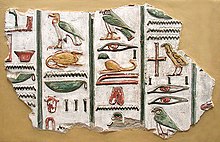Egyptian writing
| Egyptian hieroglyphs |
|
|---|---|

|
|
| Type |
Logography usable as an abjad
|
| Languages | Egyptian language |
|
Time period
|
ca. 3200 BC – AD 400 |
|
Parent systems
|
(Proto-writing)
|
|
Child systems
|
Hieratic, Demotic, Coptic, Meroitic, Proto-Sinaitic |
| Direction | Left-to-right |
| ISO 15924 | Egyp, 050 |
|
Unicode alias
|
Egyptian Hieroglyphs |
| U+13000–U+1342F | |
Egyptian hieroglyphs (/ˈhaɪərəˌɡlɪf, -roʊ-/) were the formal writing system used in Ancient Egypt. It combined logographic, syllabic and alphabetic elements, with a total of some 1,000 distinct characters.Cursive hieroglyphs were used for religious literature on papyrus and wood. The later hieratic and demotic Egyptian scripts are derived from hieroglyphic writing; Meroitic was a late derivation from demotic.
Use of hieroglyphic writing arises from proto-literate symbol systems in the Early Bronze Age, around the 32nd century BC (Naqada III), with the first decipherable sentence written in the Egyptian language dating to the Second Dynasty (28th century BC). Egyptian hieroglyphs developed into a mature writing system used for monumental inscription in the classical language of the Middle Kingdom period; during this period, the system made use of about 900 distinct signs. The writing system continued to be used throughout the Late Period, as well as the Persian and Ptolemaic periods. Late survivals of hieroglyphic use are found well into the Roman period, extending into the 4th century AD.
...
Wikipedia
